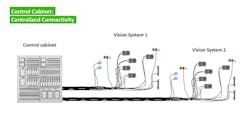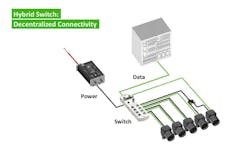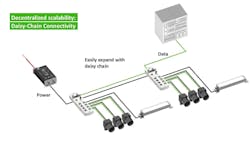How to Implement Decentralized Connectivity for Vision Systems
Editor's Note: On Vision is an ongoing series of opinion columns, providing insights about issues in machine vision and imaging.
The smart factories of Industry 4.0 are connected, highly efficient and flexible, allowing them to quickly adapt to changing product and process specifications. Vision systems are key contributors to making factories smarter. Yet the centralized, complex, and inflexible connectivity of most of them is no longer state of the art. Advanced, decentralized connectivity solutions save kilometers of cable and simplify deployment, maintenance, and adaptation to changing environments.
Machine vision systems play a central part in making manufacturing smarter and more efficient. Not only do they ensure 100% in-line quality inspection at full speed and guide robots and machines for accurate assembly, but they also collect huge amounts of data to track and trace every single product at every step of the process. This data documents the process as part of quality assurance and can also be mined for defect root cause analysis and process optimization.
Inefficient, Complex and Costly: Centralized Setup
To deliver their full value, vision systems must be fully integrated in the manufacturing process and the factory network. This allows real-time process monitoring, online configuration, and remote maintenance. The way this networking is performed on the factory floor, however, is in most cases anything but efficient.
Typically, inspection systems are connected via the control cabinet of the production line or the machine they are integrated into. The control cabinet acts as the central hub of all components and systems including vision systems but also robots, conveyor belts, machines, etc. However, vision systems are typically not connected as a complete system. Instead, every single component is controlled and connected to the cabinet: every camera, strobe, sensor, controller, etc., has a separate connection to the control cabinet. This may even include power supply.
This makes connectivity of the complete vision system highly complex and inefficient: Every camera, strobe, host computer, or other system component requires at least one connection to the cabinet. This multiplies with the number of vision systems connected to the same cabinet. Depending on the size and configuration of the facility, the cabinet may be located at a long distance from the inspection system, which means long cable lengths are needed.
Related: On Vision: Cutting Vision's Cord
This setup is outdated in many respects:
- It is complex to install and maintain, and this complexity is a source of errors and downtime.
- This complexity also means that both deployment and maintenance are time-consuming. This drives both labor costs and downtime costs.
- Connecting every single device to a remote cabinet means the distance must be covered with cables multiple times. For example, a system including four cameras and four strobes, a host PC, and four trigger sensors would require 13 power cables and 13 data cables to the control cabinet. This adds up and drives material costs of high-quality, industrial-grade cabling.
- Finally, this centralized setup makes machine vision systems inflexible. Changing the setup, for example by adding a second inspection cell or adding or removing a camera, is a complex, costly and time-consuming endeavor when our fast-paced economy demands quick adaption to change and the ability to handle a large variety of different products on the same production line.
Related: Achieving Interoperability in an Industry 4.0 Factory
Simple, Efficient and Cost-Effective: Decentralized Setup
Making vision systems easier to deploy and maintain and more flexible for future adaptations requires a paradigm shift. In terms of connectivity, vision systems should be considered for what they are: systems. Instead of connecting every single component to a remote, centralized control cabinet, it is much smarter to connect components with each other into a system first, and then connect the system to the factory network.
Modern industrial-grade connectivity switches act as a connectivity hub for the vision system. They feed every device with both power and data at the production line over short distances. If supplied with power locally, all they need is just one data connection to the control cabinet.
Related: Edge Connectivity in Industrial Applications Using 10BASE-T1S Ethernet
This decentralized approach solves many of the drawbacks of the centralized setup:
- Vision systems are easier and faster to install: All components are connected locally, only one longer data cable is required to connect the whole system to the cabinet.
- This saves time both in deployment and maintenance: no long searching through the cabinet’s connectors, no complex wiring to install and maintain.
- Saving time means lower deployment and maintenance costs and shorter downtimes.
- The decentralized setup can save miles of cables depending on the distance to the control cabinet. In our example of a four-camera system, 13 power cables and 13 data cables can be replaced with just one power cable and one data cable.
- Finally, handling vision systems as decentralized systems makes it much easier to adapt to changing needs—for example by modifying the position of the system, adding/removing/replacing components, or even adding additional systems. Some switches facilitate adaptation through daisy chain networking. That means that a second switch and a second system can be connected to the first one and share the same data connection to the cabinet. That way, an additional inspection cell can be installed without even touching the control cabinet.
In the machine vision industry, a lot of attention and development effort has been spent on camera interfaces, achieving more bandwidth over longer distance. The overall connectivity architecture, however, has not been granted a lot of attention, leaving a lot of optimization potential untapped. It is time for the industry to meet the demands of the smart factory of the future and make vision systems easier and faster to deploy, more efficient, and more flexible— with decentralized connectivity.
About the Author

Simon Knapp
Simon Knapp is the vision solutions manager at Murrelektronik GmbH (Oppenweiler, Germany), which develops power supplies, interfaces, cables and connectors, and IO Systems.



